First impressions count, and with your retail storefront, this is the one time you do want people to judge a book by its cover.
Brick and mortar stores have been hit hard this year, and they're looking for new and affordable ways to entice potential customers through their doors. As well as competing on customer experience, stores are now competing just to get people’s attention.
Merchandising and retail design are a key part of retail management strategies. In this article, we explore 10 retail storefront design tips that will help you engage customers, increase foot traffic, and most importantly, boost sales.
10 retail design tips you can use:
- Use words and quotes
- Employ a theme
- Light it up
- Add signage
- Roll out a welcome mat
- Put your bestsellers in the store window
- Set up sandwich boards
- Add flowers or planters to the entrance
- Decorate with balloons
- Add QR codes to your store window
1. Use words and quotes
What better way to let potential customers know what to expect in your store than with your own words?
Use clear window space to write sentences, words, or quotes that will appeal to passersby. With a couple of chalk pens, it’s an inexpensive, space-saving, and eye-catching way to draw people’s attention. Here are a couple of examples you can try:
- If you’re holding a sale, you can simply write the word "sale," accompanied by the discounts or deals customers can expect to find, such as 50% off or buy one item, get one free.
- When you launch a new product or service, dedicate the whole window storefront to that. In the image below, a bookstore dedicated the whole window display to a recently published book.
- Quotes, phrases, and sayings also give retail stores an interesting edge -- and also make your store a prime candidate for a social media snap, which means free publicity.
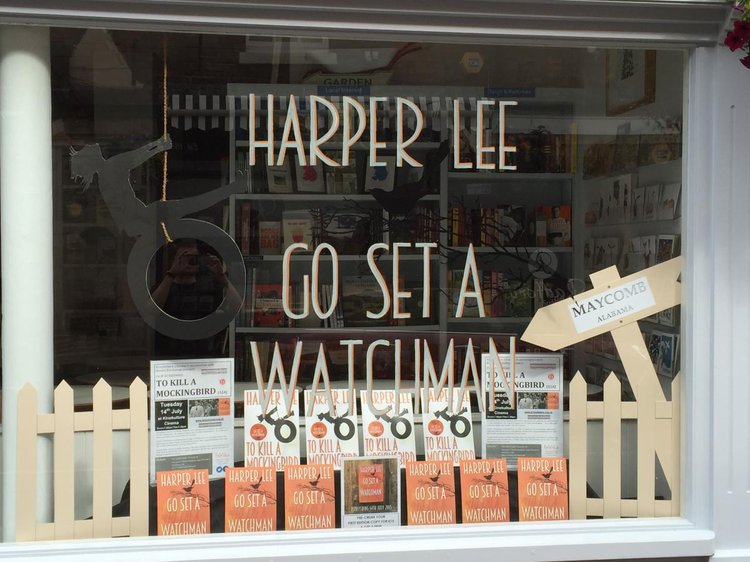
This London bookstore got creative with their window display for the launch of Harper Lee’s Image source: Author
Go Set a Watchman
. Source: thebookseller.com.
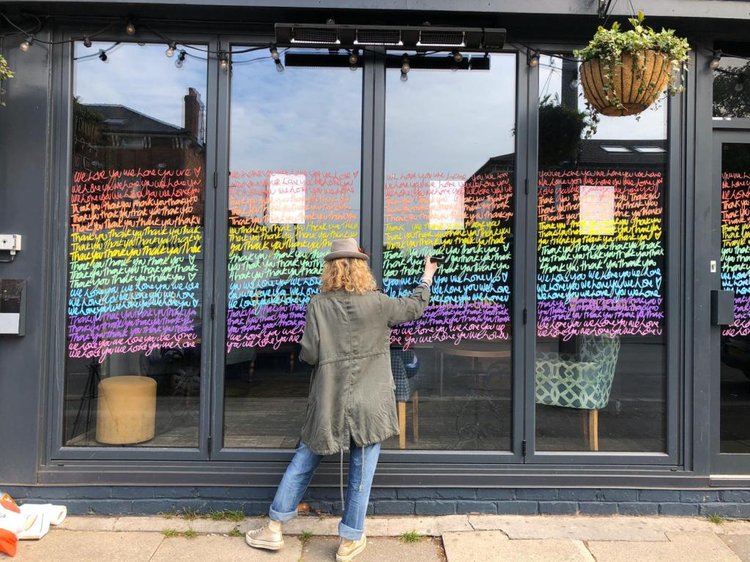
In the U.K., an artist wrote the words "we love you" and "thank you" on several retail store windows as an act of gratitude to health workers working in the midst of COVID-19. Image source: Author
2. Employ a theme
You don’t need to wait until Christmas or Halloween to give your retail storefront a theme.
In the image below, the retailer has used "a rainy day" as the central theme, adding a cozy chair and cushions as a backdrop to raindrops and clouds hung in the window.
An intentional and obvious theme helps tie the whole scene together and allows you to use merchandising techniques to situate several related products together in the storefront window.

In this theme, the retailer has brought together several products that would help someone enjoy a rainy day. Image source: Author
3. Light it up
Adding lights to your storefront display is a great way to highlight your products and retailer promotions, but lighting can also be used creatively to draw attention to your store.
Rope fairy lights can create a rustic, boutique-y ambiance, while spotlights allow you to highlight certain merchandise.
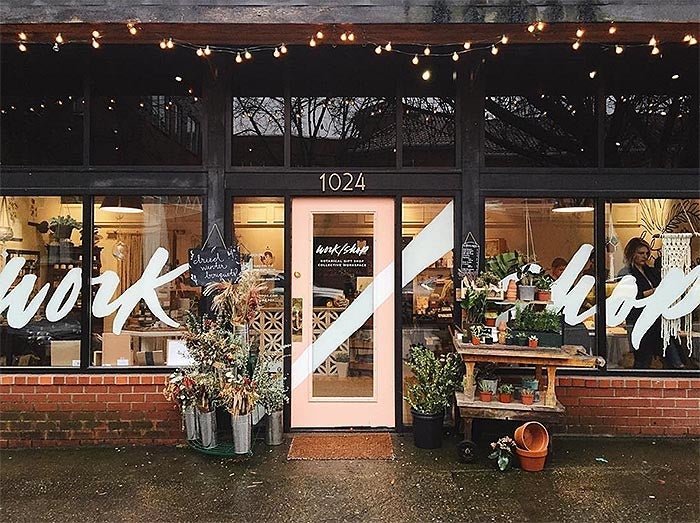
Since the store is already well-lit, this retailer has installed rope lighting above the door to draw attention. Image source: Author
4. Add signage
Signage gives you a chance to showcase your store’s branding and personality, but attractive signage also leaves an impact on customers. If your signs are unique and recognizable, they’ll be more memorable. Craft signage will appeal to your target audience, stand out from the crowd, and generate interest in your store.
Signage is also important once customers are inside your store. Clearly labeling where products can be found helps guide your customers around the store and gives your layout design a sense of organization.
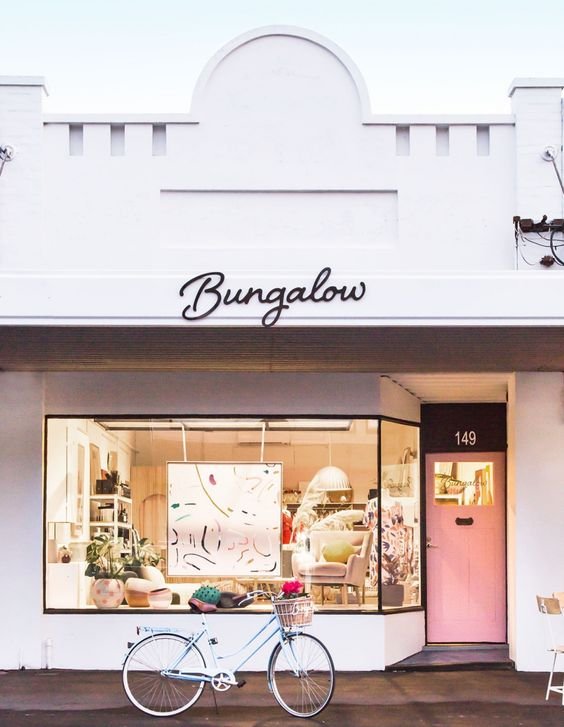
This store’s off-center yet simple signage is eye-catching and stands out clearly above the store. Image source: Author
5. Roll out a welcome mat
Laying out a welcome mat is a great way to grab the attention of passersby. Welcome mats don’t need to be typical brown mats that people expect to wipe their feet on, but something that gives an air of luxury and contrast to other stores on the same block.
You can also get creative, as Kate Spade did, by painting a mat on the floor which lets customers know they’re in for a different retail experience.
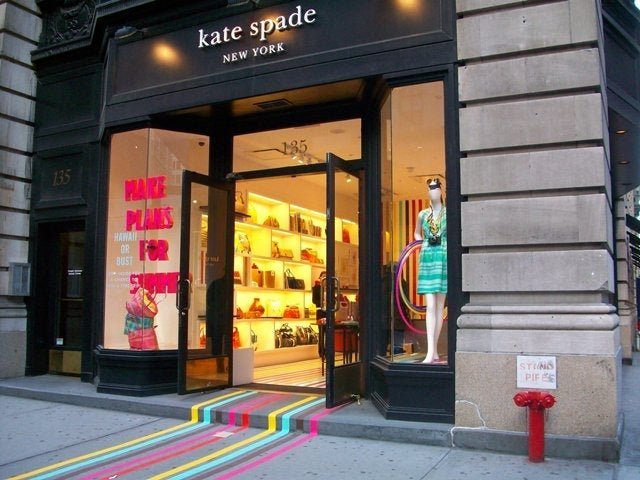
This painted doormat keeps with the Kate Spade theme and makes the entranceway look grand. Image source: Author
6. Put your best sellers in the store window
Using your retail management tool or retail POS software, you can discover your bestselling products and display them in the forefront of your storefront. You can also find out which products normally sell well together, and use cross-merchandising to place these products together.
Since your bestselling products will change over time, this gives you more opportunities to refresh your retail storefront design regularly.
7. Set up sandwich boards
Setting up sandwich boards outside your store is a tried and tested method to usher foot traffic into stores. Simple, inexpensive, and effective, a sandwich board gives you a blank canvas you can change when you see fit to pique customers’ interest.
Here are a few examples of what you can write on sandwich boards:
- Details of in-store promotions
- Information about products you sell
- Funny quotes and captions
The more often you change the messaging on your sandwich boards, the more likely it is to be memorable for passersby, especially if they usually take the same shopping routes.

Witty captions on sandwich boards, like this one at a bookstore, can capture the interests of passersby. Image source: Author
8. Add flowers or planters to the entrance
Real or fake flowers and plants can accentuate a storefront entrance. They also act as a great magnet for social media shots. Flowers can be especially eye-catching if your store is on a street without other stores, and with little color or building differentiation.
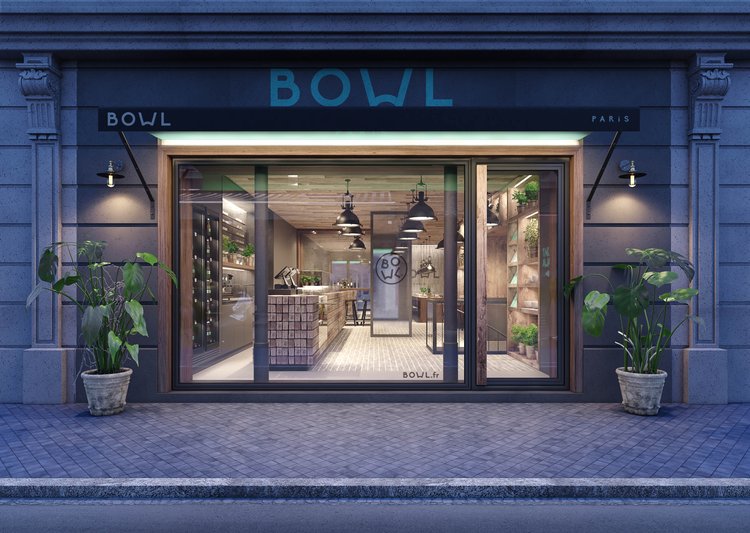
Planters placed at the ends of the store accentuate the store’s brevity. Image source: Author
9. Decorate with balloons
Don’t save balloons for your grand openings or your store’s anniversary. Done well, balloons provide a striking storefront accompaniment, and they’re a cheap investment.
Balloons work best when you’re promoting a sale, a new line, or holding an event in-store.

The balloons outside this HEMA store complement the existing storefront design. Image source: Author
10. Add QR codes to your store window
QR (quick response) codes are often offered as a mobile payment method, but they can also be a great addition to your retail storefront. They're black and white codes stuck to store windows with a sticker.
When customers scan the code with their phone camera, they can access additional information you want to give them. This gives the customer a better retail experience, especially if they don’t have time to enter your store at the moment.
Here are a few examples of information you can include in QR codes:
- Links to in-store discounts and deals
- More information on product launches
- Links to your social media pages
QR codes are a great marketing method for retail stores. By offering discounts in exchange for email addresses, you can build an email marketing database to which you can send regular emails informing people of special events, sales, and offers.

QR codes allow potential customers to find out more about products and services. Image source: Author
Retail storefront design tips to get customers in the door
Whether you’re just about to open your retail store, or you're simply looking for retail storefront design ideas to revamp your store, always keep your brand in mind when implementing new changes. What works for one store may not necessarily work for yours, and it’s important to stay true to your store’s identity.
The fun doesn’t stop there, though. Once you’ve successfully tempted customers into your store, you’ll need to make sure your store layout, shop building plan, and retail merchandising efforts are also well-thought-out to encourage customers to make a purchase.
Our Small Business Expert
We're firm believers in the Golden Rule, which is why editorial opinions are ours alone and have not been previously reviewed, approved, or endorsed by included advertisers. The Ascent does not cover all offers on the market. Editorial content from The Ascent is separate from The Motley Fool editorial content and is created by a different analyst team.